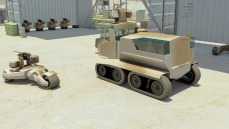Articles >>
Armoured Vehicle Study Turns Sci-fi to Sci-fact
Category: Future Technologies

FARNBOROUGH, UK -- A vehicle which can `sweat` to improve stealth was among hundreds of ideas presented to the UK Ministry of Defence from a BAE Systems study designed to show them the future. The Future Protected Vehicle programme aims to highlight both short and long-term technologies and concepts which can be used to boost the effectiveness of lightweight armoured vehicles. The numbers give an idea of the scale of the programme: 567 technologies and 244 vehicle concepts were investigated following engagement with 35 organisations. From this array of concepts, the team subsequently developed seven concept vehicles, each highlighting technologies which could support a particular specialisation. No fewer than 47 of the technologies were highlighted as being suitable for immediate pursuit. The BAE Systems team made a point of gathering ideas from as wide a spectrum as possible, including academe and industry. A series of "Dragons' Den*" style panels identified ideas for further study, funded out of the £2 million DSTL (Defence Science and Technology Laboratory) contract. The team even engaged Shanklea Primary School near Newcastle where pupils were invited to participate in design classes to stimulate interest in engineering as a career. The study was managed for the MoD by DSTL. Its land strategy lead John Hunt commented: "I was very impressed by the work. Not just by the outputs, but also the inclusivity with which the study was carried out and the robust systems engineering methodology underpinning it." "The 'quick wins' element was particularly pleasing as support to current operations is vital," Hunt added. Hisham Awad, who works on emerging technologies for BAE System's Vehicles business, commented: "BAE Systems has signalled intent for future armoured vehicles programmes by bidding and winning the research contracts that enable bright ideas to become new innovative and highly capable vehicles." The team already has a contract extension to do further work and will bid for the next phase virtual prototyping work. The seven concept vehicles were:
Ideas identified for exploitation include:
Quick wins using available technology include:
*Dragons' Den is a BBC TV programme in which budding entrepreneurs bid for cash from venture capital "dragons" for their business ideas. |
BAE Systems |
TEMPORARY COMPANY GROUPING EBMR MEETS ITS DELIVERY OBJECTIVES FOR 2019
14.01.2020
BAE Systems` CV90 increases lethality by testing SPIKE LR anti-tank guided missile
14.01.2020
BAE Systems Land Systems Hagglunds AB
Hotspur Armoured Products Limited
BAE SYSTEMS Advanced Technology Centre
BAE SYSTEMS Customer Solutions & Support Land & Sea
BAE SYSTEMS Operational Training
BAE SYSTEMS RO Defence Small Arms Ammunition Division
BAE Systems North America, Land & Information Systems
Armoured Project Vehicles Ltd - APV
Discuss
